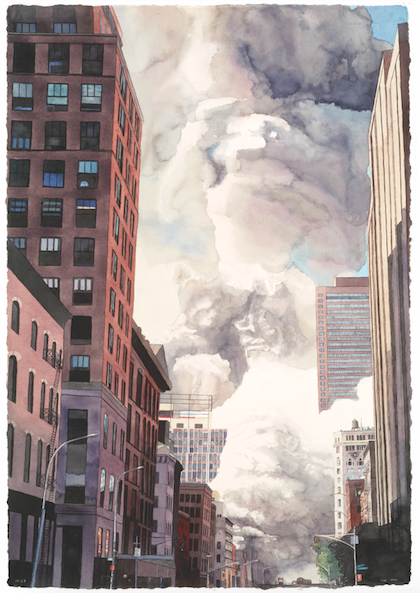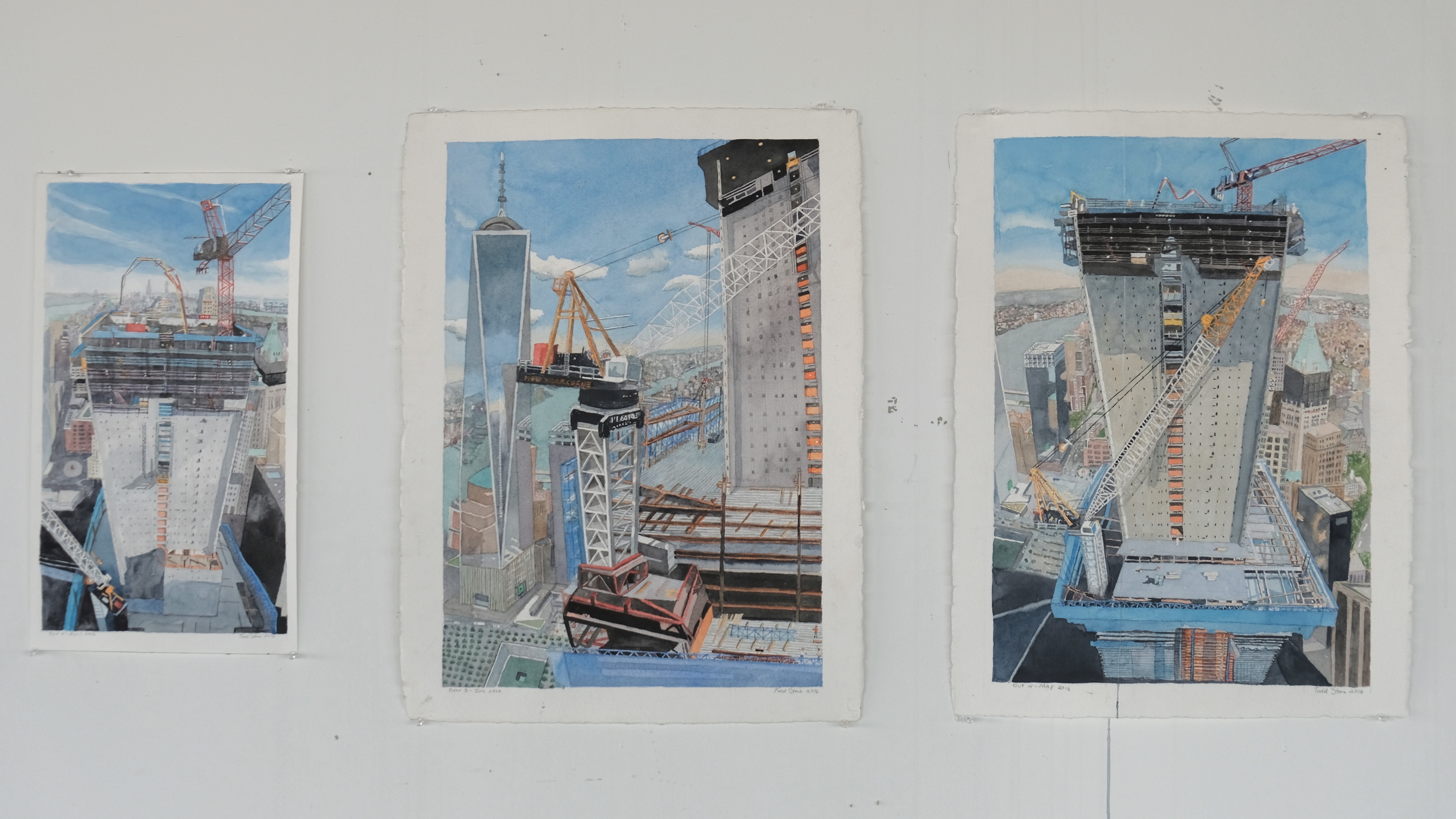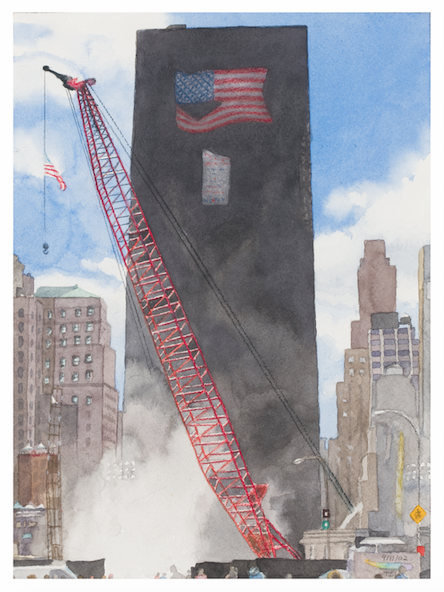An artist in lower Manhattan recalls how he watched the Twin Towers fall, then spent years honoring the lives lost.
-
September/October 2021
Volume66Issue6
Editor's note: Todd Stone is an artist whose watercolors and oil paintings over the last 20 years have examined the destruction of the World Trade Center on September 11, 2001, and the ongoing recovery in Lower Manhattan. A native New Yorker, Todd moved to Lower Manhattan in 1974 and set up shop, showing his work internationally. At the time, his art was primarily abstract, but by 2000 Todd had expanded his practice to include studio scenes, landscapes, and cityscapes, often featuring the World Trade Center. His home and studio were literally in the shadow of the Twin Towers.
My wife and I were in my Tribeca studio on that sunny morning when the first jet roared over our skylight and slammed into the North Tower six blocks away.
My camera was already at the window as I had been photographing the melancholy, rainy rooftops the previous day, and I took my first photograph within seconds of impact as the pigeons were lifting to the sound of the explosion at 8:45.
When the second tower fell, the studio suddenly flooded with light. I had been living in the shadow of the towers for twenty-two years. But this new light had shadows of its own.
Shortly after, I was on a neighboring rooftop when the South Tower collapsed in my camera viewfinder. The camera shutter froze as I looked on in disbelief. I ran for my life from the debris cloud but was only dusted as the cloud dissipated as it reached me.
We thought the attacks were ongoing as explosions continued through the afternoon. There was no electricity or phone service.
I spent the rest of the day on my rooftop drawing and photographing in a dazed state of confusion until Seven World Trade Center fell at 4:30.

My family evacuated uptown to 26th Street that night but returned the next day to find our home transformed and unlivable. We needed masks to breathe in our smoke-filled loft. The streets were filled with firemen, disaster workers and crushed vehicles. That night we were again evacuated due to the bomb threat at the Empire State building.
We hit the street to panicked crowds yelling “run south”. We had just come from the south.
We returned home after four days to what had become ground zero. We lived behind swat team barricades for the next four months as the building across the street was identified as a potential terror target. Our phone service was not restored until December 12th.
Before the terrible events on 9/11, my work was already deeply rooted in views of New York City. As a skyline painter, I found myself prepared for the events that sunny morning when the first plane came roaring overhead and I hit the floor; I thought it was a missile.
I had a camera at the window, because I'd been photographing the day before from my home in TriBeCa and captured the moment after impact when pigeons lifted from the explosion.
In the immediate aftermath, my family and I lived with the continued burning of the rubble of the World Trade Center. We chose to stay in Lower Manhattan because it seemed like the patriotic thing to do.
The “Witness” series of watercolors that resulted from those photographs would become just one in a body of work that has consumed me over the last twenty years, something I consider documentation of not only the tragedy that would traumatize people all over the world, but also the reimagining of Lower Manhattan.
I brought my work to the attention of Silverstein Properties, the lead developer of the World Trade Center site. In the end, I was invited inside the World Trade Center as an artist in residence, on the 48th floor of 7WTC as my workspace, the first of the rebuilt towers.
Downtown has come a long way over the last twenty years. The rebuilding shows the resilience of the collective human spirit that all should celebrate. My work is an elegy for those lost here and a celebration of the workers and community who brought the vision of the rebuilt World Trade Center to life again.
After this great tragedy came controversy over what should be done with Lower Manhattan, how do we memorialize thousands who died that day with the commercial demands of re-development. While I initially opposed the rebuilding of the World Trade Center, the years and progress made here have changed my mind. The design of the Memorial was an open, crowd-sourced competition won by a relatively unknown Israeli architect, Michael Arad.

All of the stake holders came together to design a final working plan that rebuilt the World Trade Center, all while keeping Lower Manhattan functional.
All of this was the confluence of a lot of creative energy, all of the designers came together to come together with a final working plan that rebuilt the World Trade Center all while keeping Lower Manhattan functional.
The subways and the Port Authority Trans-Hudson trains all remained in service as the construction commenced. The final WTC plan was a compromise between commerce and a memorial, it’s a reflection of the city's function.
Silverstein Properties has offered me an incredible form of art patronage through corporate social responsibility, of supporting the arts in a unique way. I found myself as a nerve cell in the membrane of the rebuilding effort.
I now see how the city is always rebuilding, always eating its history.

One of the motifs I found some solace in was the appearance of building cranes at the site of the World Trade Center. In Japan, the crane is a symbol of good luck, linking heaven and earth.
Many of the paintings I have created since 9/11 incorporate these towering tools of high-rise construction and I try to make them beautiful.
When I’m doing these strokes and counting, I’m trying to get to 3,000. I do it over and over again as a way to get my head around the loss of life.
One of my paintings is inspired by September 11, 2002.
This was the first time the site had been emptied and families invited back. This wind came up, and all of this dust was unsettled from the floor of the World Trade Center.
All of these unsettled spirits rose.
When the towers fell, there was an upward draft. I'm very conscious of the upper draft when I'm at the World
Trade Center where the reflecting pools are. Even those two fountains create an upward draft, you can feel the air moving and it's reminiscent of that to me.
When people who are sensitive to the spirit – I don't consider myself to be particularly sensitive – come down to the memorial, they feel the unsettled energy.
In all, these 40 paintings have been my answer to the call of history. This wasn't something I asked for, but I was uniquely positioned to do this. I did my work, just like the cops, just like the firemen, and with its own consequences. Not the same consequence they paid, but with an emotional price.
This work is outside of the art world. This work finds its audience, those who are drawn to this site, find this work. It’s different than looking at news footage. Hopefully my pictures have been humanized, spiritualized in a different way than the photo image. These have come through the hand and the heart.


